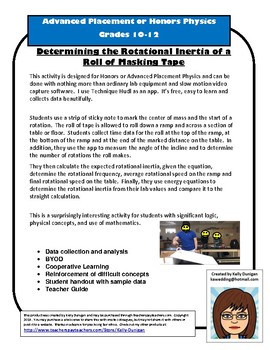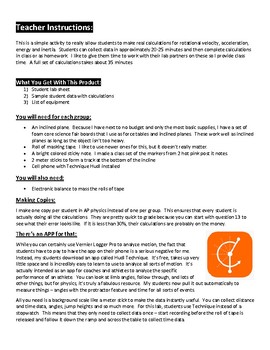Rotational Inertia of a Roll Of Masking Tape Lab - Honors or AP Physics
- PDF
What educators are saying
Description
Determining the Rotational Inertia of a Roll of Masking Tape
This activity is designed for Honors or Advanced Placement Physics and can be done with nothing more than ordinary lab equipment - meter sticks, a balance, and an inclined plane (I use foam core science fair boards) and slow motion video capture software. I use Technique Hudl as an app. It’s free, easy to learn and collects data beautifully but you can use any slo-motion app you'd like or even use a stop watch though your data won't be as good.
Students use a strip of sticky note to mark the center of mass and the start of a rotation. The roll of tape is allowed to roll down a ramp and across a section of table or floor. Students collect time data for the roll at the top of the ramp, at the bottom of the ramp and at the end of the marked distance on the table. In addition, they use the app to measure the angle of the incline and to determine the number of rotations the roll makes.
They then calculate the expected rotational inertia, given the equation, determine the rotational frequency, average rotational speed on the ramp and final rotational speed on the table. Finally, they use energy equations to determine the rotational inertia from their lab values and compare it to the straight calculation. The percent difference is quite tolerable.
This is a surprisingly interesting activity for students with significant logic, physical concepts, and use of mathematics.
· Data collection and analysis
· BYOD
· Cooperative Learning
· Reinforcement of difficult concepts
· Student handout with sample data
· Teacher Guide
Keywords: rotation, revolution, oscillation, simple harmonic motion, angular velocity, angular momentum, angular acceleration, translational velocity, linear velocity, rotational inertia, inertia, lab, laboratory, experiment, activity, speed, roll, rolling





